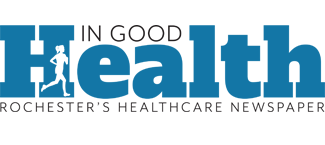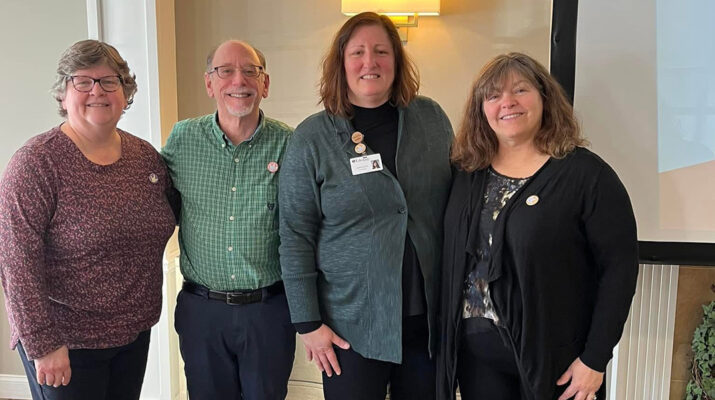The Deaf Senior Services Coalition, teamed with Lifespan and other organizations, is trying to increase health service accessibility for older area residents who are deaf. A big goal: to find more volunteer respite caregivers
By John Addyman
 We so confidently take our ability to communicate for granted.
We so confidently take our ability to communicate for granted.
There’s no trouble asking a wife what’s for dinner or did the husband take out the garbage. We can easily tell the barber how to cut our hair and instruct the nail specialist which colors to use. When we go to the doctor, we can tell her where it hurts. Even with a mouthful of appliances, we can tell the dentist how often we floss.
But many of our brothers and sisters in the Rochester area have great difficulty with those things.
Karen Putz explains.
She’s deaf.
“I moved here from Chicago,” she said. “I was shocked to find out that we did not have any type of organization or services for people 55 and older and deaf. Did you know that Rochester has the largest per capita deaf population in the nation, yet we lack services for people 55 and up? There were no services accessible and ready for us in assisted living facilities. None. If we have to move into a nursing home tomorrow, there are none that are accessible and ready for us. We need to give this attention and to make sure we have places to go and housing that is accessible to us, services that are accessible to us. We are getting old here. In the next five to 10 years, we will need a large amount of services and we need to be prepared for that.”
Incredible but true, COVID-19 rang a big bell that the hearing community never heard, but the deaf community was shaken by it.
Putz, an author who is the Rochester Deaf Academy representative for the Deaf Senior Services Coalition, said COVID hit the hearing-impaired community particularly hard.
“There was a dark realization we did not have coordinated services for the deaf community in terms of access to interpreters, access to hospital and care facilities who had an understanding of deaf older patients,” she said. “We had a higher fatality rate, a higher hospitalization rate because of lack of communication, the lack of information sharing.”
A simple issue blew up.
People trying to communicate with a deaf person who was seriously ill, tried writing notes.
But the first language for many deaf people is American Sign Language, not written English or Spanish. If no one at the hospital had ASL training, many deaf sick people were out of luck.
Worse, people who were deaf and blind, who communicated by ASL drawn on their hands, “were literally left in the dark.”
The issue didn’t stop with COVID and wasn’t confined to Rochester.
In April, at the Van Duyn Nursing Home in Syracuse, state health inspectors found that two deaf seniors were unable to communicate with their caregivers for more than a year. A state inspector wrote that the residents could not communicate when they were hungry, did not feel good or if they had specific needs. They were just alone and … no one cared about them.
“That is precisely why we formed the Deaf Senior Services Coalition,” said executive director Steve Lovi. “We’re working with New York Connect, a statewide information and referral program, with Monroe County Office of Aging, and with Lifespan to offer recommendations to increase accessibility. We are a group of advocates, service providers and healthcare systems committed to creating and ensuring an ASL continuum of care in the Rochester 55-plus community.”
“We identify systems that are not accessible for the deaf consumer: they’re not deaf-friendly, there are no interpreters and the deaf person cannot effectively express themselves. Then we try to break down the barriers in those systems,” Putz added.
Lovi said, “American Sign Language is our first language, which is a visual language as opposed to a written language. Translating written language into ASL makes it easier for us to understand.”
“There’s a misconception or myth that ‘captions or written notes will solve the problem of communication,” Putz said. “But again, that’s not our first language, it’s not an effective communication.”
DSSC feels the perfect solution to help deaf residents communicate in a senior living facility would be to have an ASL-trained person on site. Today’s reality is different.
“There will not always be an ASL interpreter on site and available 24/7,” Lovi said. “What we do is work with the deaf person to set expectations, what kind of activities or events would they need an interpreter for?”
DSSC supplies a listing of ASL interpreters.
At Episcopal Senior Living, for instance, Lovi explained that a resident can contact the activities director and say, “I want to go to these events – swimming, poker, a special dinner” and the director will call the interpreters agency. Under the Americans with Disabilities Act (ADA), agencies and service providers are required to pay for a resident’s interpreting services as their cost of doing business.
New project
DSSC has teamed up with Lifespan in a new project to find volunteer respite caregivers to support deaf people with dementia in their homes. It’s an ambitious program that combines Lifespan’s expertise with dementia clients and DSSC’s abilities with the deaf and hard-of-hearing.
Katy Allen, Lifespan’s division leader for caregiver services and director of the Finger Lakes Caregiver Institute, said her group is gearing up quickly to expand the Partners in Caring Respite program to serve the deaf community.
“We will be pounding the pavement with the DSSC, looking for families in need,” she said. “We’re here to support them, and we’re looking for ASL volunteers.”
Lifespan received a $125,000 grant to expand several pieces the respite program. “We will be recruiting families and volunteers at health fairs, volunteer fairs, and we will do outreach in faith communities and at NTID (National Technical Institute for the Deaf) and at Rochester Institute of Technology,” Allen added.
“The beauty of our program is that families and their volunteers will be able to develop wonderful and supportive relationships. We’re here to facilitate that by providing safety infrastructure support to the family and the volunteer to ensure success,” she said.
Lifespan has 60 active dementia respite volunteers spread out over Monroe, Livingston, Wayne and Ontario counties and sadly, with 40 families on the waiting list for a volunteer. Now turning to include the deaf, “It made sense for us to partner with the DSSC,” Allen said. “Their whole mission is to work with deaf older adults.”
Volunteers have to be at least 18 years old, but most in the Lifespan program are older than 50, many working part-time or retired. The majority of people with dementia being served are 60 or older.
“My hope is that our first volunteers for the deaf/dementia program would start by the end of October,” Allen said. “It takes a long time to recruit volunteers for this kind of work, which means going into people’s homes, and it’s long-term. If we can serve more than 10 families, getting more than 10 volunteers on board in next nine months, I’d be thrilled.
“The match is key to the success. We very carefully match volunteers with family. We consider the location — most volunteers want to stay near the county where they live. Volunteers will have specific needs. They may only want to work with a man or a woman. They may have allergies to pets or may not be able to navigate stairs or be concerned about a smoker in the home. We do a lot of work to assess the family, the home, pets, a smoker, the interests of the person with dementia. We’re matching a volunteer who will be able to establish a strong lasting relationship.”
Respite caregivers will be asked to commit to at least two visits a month. Allen said most volunteer caregivers visit once a week for three hours each trip. The volunteer process includes about five hours of training, a background check and interview.
“We make sure everyone understands what Lifespan is, our mission, who we serve, specifics of the program, communication, boundary-setting, do’s and don’ts of being a volunteer in someone’s home, best practices, suggestions for activities for the volunteers and things they can do with the person with dementia,” she said. “We want to make sure volunteers know different programs and supports available and how they can get in touch with us.”
DSSC will provide Lifespan with two team members to assist with outreach programs to recruit deaf persons or ASL-fluent respite volunteers. Another member to serve as a trainer for Lifespan staff and assist in onboarding volunteers. DSSC will also help design outreach materials and presentations to the deaf community.
“This is not a local issue,” said Putz. “It’s a big wide issue. It took many years to get the state Office for the Deaf and Hard of Hearing to recognize the lack of coordinated services across the state…we will help the state better manage resources that are long overdue for the deaf community.”

